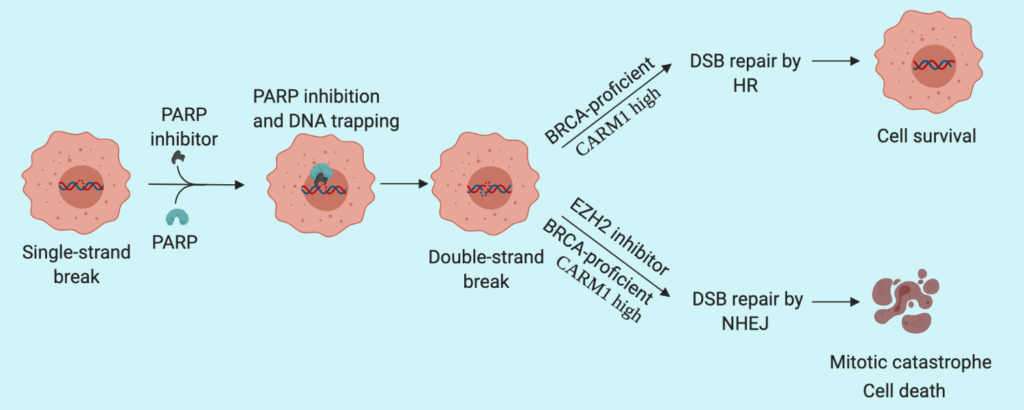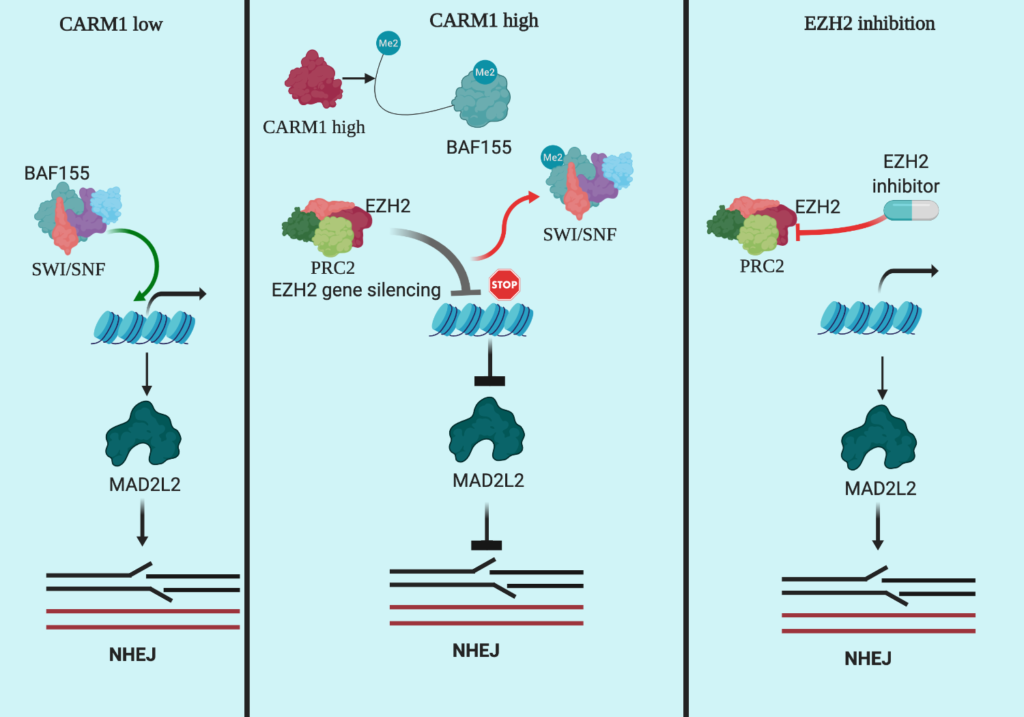Homologous recombination (HR) is a precise DNA repair mechanism, which is impaired in BRCA-mutant tumors. PARP inhibitors are effective against BRCA1/2-mutant breast and ovarian cancers due to the deficiency in HR-mediated DNA repair. Consistently HR proficient tumors are resistant to PARP inhibitors. In a recently published article in the journal Cancer Cell, Karakashev et al. identified transcriptional repressor EZH2 inhibition as a target to sensitize HR proficient, CRAM1-high ovarian cancers to PARP inhibitor.
EZH2 and PARP inhibitors
EZH2 is the catalytic subunit of the polycomb repressive complex 2 (PRC2). EZH2 participates in transcriptional repression by catalyzing the methylation of histone H3 (H3K27me3) of the chromatin. The modification limits the accessibility of the transcriptional machinery to the DNA thus repressing its target genes. In the case of cancer, EZH2 like any other transcriptional repressor switches off the expression of tumor suppressor genes, therefore making it an attractive target for anticancer therapy. Several EZH2 inhibitors including GSK126 and UNC1999 are available to assess their efficacy against cancer. Recently, EZH2 inhibitor tazemetostat (EPZ-6438) was approved by the FDA for the treatment of metastatic or locally advanced epithelioid sarcoma. Poly (ADP-ribose) polymerase (PARP), a family of the protein linked to the damaged DNA repair. Blocking PARP with specific inhibitors prevents cancer cells from repairing their damaged DNA. Indeed, PARP inhibitor (PARPi), olaparib is approved to treat homologous recombination (HR)-deficient breast and ovarian cancers.
EZH2 inhibition sensitizes ovarian cancers to PARP inhibitor
CARM1 (also known as PRMT4) is amplified/overexpressed in 20% of High-grade serous ovarian cancers (HGSOCs).CARM1-high HGSOCs are typically HR-proficient. Karakashev et al. showed that the combination of EZH2 inhibitor GSK126 and PARP inhibitor olaparib facilitates the immune cell-mediated killing of CARM1-high ovarian cancer cells. Additionally, the CARM1-knockout (CARM1-KO) cells didn’t respond to the combination treatment. Furthermore, two different EZH2 inhibitors, as well as knockdown of EZH2, decreased IC50 of PARP inhibitors olaparib, rucaparib and cisplatin in CARM1- high but not CARM1-KO cells. Together, they concluded that EZH2 inhibitors sensitize CARM1-high ovarian cancer cells to PARP inhibitors.

MAD2L2 is a connecting link between EZH2 and PARP inhibitors response
To screen CARM1 dependent downstream targets, Karakashev et al. utilized RNAseq and ChIP-seq data from CARM1-high and CARM1 knockout cells. The analysis revealed enrichment of the MAD2L2 gene, a regulator of non-homologous end-joining (NHEJ) DNA repair pathways, as an EZH2 target gene. They observed MAD2L2 upregulation at both mRNA and protein levels in CARM1 knockout cells as well as GSK126 (EZH2 inhibitor) treated CARM1-high cells, suggesting EZH2 and CARM1 are components of the same pathway. Consistent with the previous reports, and by using genetic tools Karakashev et al. deciphered that in ovarian cancer cells CARM1 methylates the BAF155 (SMARCC1) subunit of the SWI/SNF complex. Incidentally, BAF155 methylation drives the switch from SWI/SNF complex to the EZH2-mediated silencing of NHEJ regulator MAD2L2. Mechanistically, in CARM1-high ovarian cancer cells, EZH2 inhibitor treatment upregulated MAD2L2 and associated increase in NHEJ activity resulting in sensitizing these cells to PARP inhibitor. The observation established MAD2L2 as a key link between EZH2 inhibition and sensitization to PARP inhibitor.

In vivo, EZH2 and PARP inhibitor combination suppresses tumor growth in Orthotopic and Patient-Derived Xenograft (PDX), models
Karakashev et al. tested that EZH2 and PARP inhibitor combination causes chromosomal instability and mitotic catastrophe in CARM1-high ovarian cancer cells. To demonstrate the effect of these inhibitors in vivo, they established CARM1-high orthotopic and PDX models. Consistent with the in vitro findings, EZH2 and PARP inhibitors combination reduced tumor growth in CARM1-high PDX and orthotopic mouse models, but not in CARM1-low/deficient tumor models. CARM1-high tumors demonstrated increased apoptosis and chromosomal instability with the combination treatment.
In summary, Karakashev et al. demonstrate that targeting EZH2 sensitizes CARM1-high ovarian cancers to PARP inhibitors by MAD2L2 upregulation and increased NHEJ activity. They provide evidence that the combination of EZH2 and PARP inhibitors is lethal for ovarian cancer cells. Furthermore, the combination suppressed tumor in both orthotopic and PDX in vivo models by inducing apoptosis and increasing chromosomal instability. The findings provide a strategy to therapeutically utilize PARP inhibitors in BRCA1/2 proficient tumors.
By Sushil Tripathi

Reference
Karakashev, S., et al. (2020). “EZH2 Inhibition Sensitizes CARM1-High, Homologous Recombination Proficient Ovarian Cancers to PARP Inhibition.” Cancer Cell

